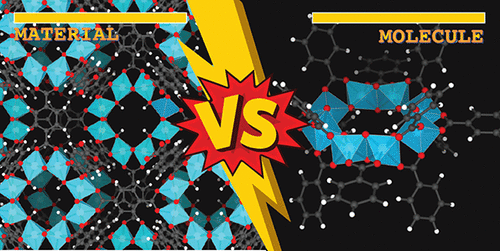当前位置:
X-MOL 学术
›
Chem. Rev.
›
论文详情
Our official English website, www.x-mol.net, welcomes your
feedback! (Note: you will need to create a separate account there.)
Electronic Structure Modeling of Metal-Organic Frameworks.
Chemical Reviews ( IF 51.4 ) Pub Date : 2020-07-16 , DOI: 10.1021/acs.chemrev.0c00148 Jenna L Mancuso 1 , Austin M Mroz 1 , Khoa N Le 1 , Christopher H Hendon 1
Chemical Reviews ( IF 51.4 ) Pub Date : 2020-07-16 , DOI: 10.1021/acs.chemrev.0c00148 Jenna L Mancuso 1 , Austin M Mroz 1 , Khoa N Le 1 , Christopher H Hendon 1
Affiliation

|
Owing to their molecular building blocks, yet highly crystalline nature, metal–organic frameworks (MOFs) sit at the interface between molecule and material. Their diverse structures and compositions enable them to be useful materials as catalysts in heterogeneous reactions, electrical conductors in energy storage and transfer applications, chromophores in photoenabled chemical transformations, and beyond. In all cases, density functional theory (DFT) and higher-level methods for electronic structure determination provide valuable quantitative information about the electronic properties that underpin the functions of these frameworks. However, there are only two general modeling approaches in conventional electronic structure software packages: those that treat materials as extended, periodic solids, and those that treat materials as discrete molecules. Each approach has features and benefits; both have been widely employed to understand the emergent chemistry that arises from the formation of the metal–organic interface. This Review canvases these approaches to date, with emphasis placed on the application of electronic structure theory to explore reactivity and electron transfer using periodic, molecular, and embedded models. This includes (i) computational chemistry considerations such as how functional, k-grid, and other model variables are selected to enable insights into MOF properties, (ii) extended solid models that treat MOFs as materials rather than molecules, (iii) the mechanics of cluster extraction and subsequent chemistry enabled by these molecular models, (iv) catalytic studies using both solids and clusters thereof, and (v) embedded, mixed-method approaches, which simulate a fraction of the material using one level of theory and the remainder of the material using another dissimilar theoretical implementation.
中文翻译:

金属有机框架的电子结构建模。
由于它们的分子构造基团,但仍具有高度结晶性,因此金属有机框架(MOF)位于分子与材料之间的界面。它们的不同结构和组成使其成为有用的材料,可作为异相反应中的催化剂,能量存储和转移应用中的电导体,光致化学转化中的生色团等。在所有情况下,密度泛函理论(DFT)和用于电子结构确定的高级方法都可提供有关支持这些框架功能的电子特性的有价值的定量信息。但是,传统的电子结构软件包中只有两种通用的建模方法:将材料视为扩展的周期性实体,以及将材料视为离散分子的材料。每种方法都有其特点和优点。两者都被广泛地用来理解由金属-有机界面形成而产生的新兴化学反应。这篇综述探讨了迄今为止的这些方法,重点放在电子结构理论在探索使用周期性,分子和嵌入式模型的反应性和电子转移方面的应用。其中包括(i)计算化学方面的考虑因素,例如功能,重点放在电子结构理论的应用上,以利用周期性,分子和嵌入式模型探索反应性和电子转移。其中包括(i)计算化学方面的考虑因素,例如功能,重点放在应用电子结构理论研究使用周期性,分子和嵌入式模型的反应性和电子转移。其中包括(i)计算化学方面的考虑因素,例如功能,选择k- grid和其他模型变量以深入了解MOF属性,(ii)将MOF视为材料而非分子的扩展固体模型,(iii)这些分子模型支持的团簇提取机理和后续化学反应,( iv)使用固体及其团簇进行催化研究,以及(v)嵌入的混合方法,使用一种理论水平模拟一部分材料,使用另一种不同理论实现模拟材料的其余部分。
更新日期:2020-08-26
中文翻译:

金属有机框架的电子结构建模。
由于它们的分子构造基团,但仍具有高度结晶性,因此金属有机框架(MOF)位于分子与材料之间的界面。它们的不同结构和组成使其成为有用的材料,可作为异相反应中的催化剂,能量存储和转移应用中的电导体,光致化学转化中的生色团等。在所有情况下,密度泛函理论(DFT)和用于电子结构确定的高级方法都可提供有关支持这些框架功能的电子特性的有价值的定量信息。但是,传统的电子结构软件包中只有两种通用的建模方法:将材料视为扩展的周期性实体,以及将材料视为离散分子的材料。每种方法都有其特点和优点。两者都被广泛地用来理解由金属-有机界面形成而产生的新兴化学反应。这篇综述探讨了迄今为止的这些方法,重点放在电子结构理论在探索使用周期性,分子和嵌入式模型的反应性和电子转移方面的应用。其中包括(i)计算化学方面的考虑因素,例如功能,重点放在电子结构理论的应用上,以利用周期性,分子和嵌入式模型探索反应性和电子转移。其中包括(i)计算化学方面的考虑因素,例如功能,重点放在应用电子结构理论研究使用周期性,分子和嵌入式模型的反应性和电子转移。其中包括(i)计算化学方面的考虑因素,例如功能,选择k- grid和其他模型变量以深入了解MOF属性,(ii)将MOF视为材料而非分子的扩展固体模型,(iii)这些分子模型支持的团簇提取机理和后续化学反应,( iv)使用固体及其团簇进行催化研究,以及(v)嵌入的混合方法,使用一种理论水平模拟一部分材料,使用另一种不同理论实现模拟材料的其余部分。











































 京公网安备 11010802027423号
京公网安备 11010802027423号